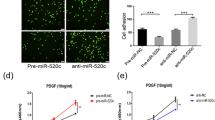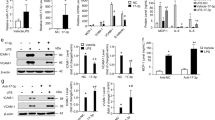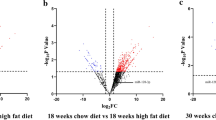Abstract
Background
MicroRNA-1290 (miR-1290) has been reported to be involved in many diseases and play a key role during the development process. However, the role of miR-1290 in atherosclerosis (AS) is still unclear.
Methods and results
The current study showed that the expressions of miR-1290 were high in serum of patients with hyperlipidemia. The functional role of miR-1290 were then investigated in human umbilical vein endothelial cells (HUVECs). Here, we found that miR-1290 expressions were notably enhanced in HUVECs mediated by IL-8. miR-1290 inhibitor repressed monocytic THP-1 cells adhesion to HUVECs by regulating ICAM-1 and VCAM-1, inhibited proliferation through regulating cyclinD1 and PCNA, and inhibited inflammatory response by regulating IL-1β. Mechanistically, we verified that miR-1290 mimic was able to directly target the 3′-UTR of GSK-3β mRNA using luciferase reporter assay. Knockdown of GSK-3β (si-GSK-3β) promoted HUVECs adhesion and the expression of IL-1β, and partially restore the depression effect of miR-1290 inhibitor on HUVECs adhesion and inflammation. In contrast, si-GSK-3β inhibited the proliferation of HUVECs and the expression of cyclinD1 and PCNA.
Conclusions
In summary, our study revealed that miR-1290 promotes IL-8-mediated the adhesion of HUVECs by targeting GSK-3β. However, GSK-3β is not the target protein for miR-1290 to regulate the proliferation of HUVECs. Our findings may provide potential target in atherosclerosis treatment.







Similar content being viewed by others
References
Ross R (1999) Atherosclerosis—an inflammatory disease. N Engl J Med 340(2):115–126
Ramji DP, Davies TS (2015) Cytokines in atherosclerosis: key players in all stages of disease and promising therapeutic targets. Cytokine Growth Factor Rev 26(6):673–685
DeGraba TJ (2003) The role of inflammation in atherosclerosis. Adv Neurol 92:29–42
Chistiakov DA et al (2018) Potential of anti-inflammatory agents for treatment of atherosclerosis. Exp Mol Pathol 104(2):114–124
Gerszten RE et al (1999) MCP-1 and IL-8 trigger firm adhesion of monocytes to vascular endothelium under flow conditions. Nature 398(6729):718–723
Yue TL et al (1994) Interleukin-8. A mitogen and chemoattractant for vascular smooth muscle cells. Circ Res 75(1):1–7
Qin Y et al (2013) Recombinant human CXCL8(3–72)K11R/G31P regulates smooth muscle cell proliferation and migration through blockage of interleukin-8 receptor. IUBMB Life 65(1):67–75
Stark A et al (2005) Animal microRNAs confer robustnessto geneexpression andhave a significant impact on 3’UTR evolution. Cell 123(6):1133–1146
Novak J et al (2015) Mechanistic role of microRNAs in coupling lipid metabolism and atherosclerosis. Adv Exp Med Biol 887:79–100
Feinberg MW, Moore KJ (2016) MicroRNA regulation of atherosclerosis. Circ Res 118(4):703–720
Santulli G (2015) MicroRNAs distinctively regulate vascular smooth muscle and endothelial cells: functional implications in angiogenesis, atherosclerosis, and in-stent restenosis. Adv Exp Med Biol 887:53–77
Giral H, Kratzer A, Landmesser U (2016) MicroRNAs in lipid metabolism and atherosclerosis. Best Pract Res Clin Endocrinol Metab 30(5):665–676
Wang J et al (2019) MicroRNA-92a promotes vascular smooth muscle cell proliferation and migration through the ROCK/MLCK signalling pathway. J Cell Mol Med 23(5):3696–3710
Lin M et al (2016) sMicroRNA-1290 inhibits cells proliferation and migration by targeting FOXA1 in gastric cancer cells. Gene 582(2):137–142
Yan L et al (2018) MiR-1290 promotes proliferation, migration, and invasion of glioma cells by targeting LHX6. J Cell Physiol 233(10):6621–6629
Xiao X et al (2018) miR-1290 promotes lung adenocarcinoma cell proliferation and invasion by targeting SOCS4. Oncotarget 9(15):11977–11988
Yue KY et al (2019) Neurons can upregulate Cav-1 to increase intake of endothelial cells-derived extracellular vesicles that attenuate apoptosis via miR-1290. Cell Death Dis 10(12):869
Wang Q et al (2021) Exosomal MiR-1290 promotes angiogenesis of hepatocellular carcinoma via targeting SMEK1. J Oncol 2021:6617700
Li M et al (2021) TMEM98, a novel secretory protein, promotes endothelial cell adhesion as well as vascular smooth muscle cell proliferation and migration. Can J Physiol Pharmacol 99(5):536–548
Warboys CM et al (2014) Bidirectional cross-regulation between the endothelial nitric oxide synthase and beta-catenin signalling pathways. Cardiovasc Res 104(1):116–126
Lin P et al (2015) Idebenone protects against oxidized low density lipoprotein induced mitochondrial dysfunction in vascular endothelial cells via GSK3beta/beta-catenin signalling pathways. Biochem Biophys Res Commun 465(3):548–555
Bedel A et al (2008) E-cadherin/beta-catenin/T-cell factor pathway is involved in smooth muscle cell proliferation elicited by oxidized low-density lipoprotein. Circ Res 103(7):694–701
Zhang YZ et al (2018) Vascular peroxide 1 promotes ox-LDL-induced programmed necrosis in endothelial cells through a mechanism involving beta-catenin signaling. Atherosclerosis 274:128–138
Wei J et al (2020) Serum miR-1290 and miR-1246 as potential diagnostic biomarkers of human pancreatic cancer. J Cancer 11(6):1325–1333
Liu X et al (2019) Circulating miR-1290 and miR-320d as novel diagnostic biomarkers of human colorectal cancer. J Cancer 10(1):43–50
Zhou W et al (2017) miR-196b/miR-1290 participate in the antitumor effect of resveratrol via regulation of IGFBP3 expression in acute lymphoblastic leukemia. Oncol Rep 37(2):1075–1083
Wu K et al (2017) Asiatic acid enhances survival of human AC16 cardiomyocytes under hypoxia by upregulating miR-1290. IUBMB Life 69(9):660–667
Libby P (2012) Inflammation in atherosclerosis. Arterioscler Thromb Vasc Biol 32(9):2045–2051
Wu G et al (2020) Molecularly engineered macrophage-derived exosomes with inflammation tropism and intrinsic heme biosynthesis for atherosclerosis treatment. Angew Chem Int Ed Engl 59(10):4068–4074
Cybulsky MI, Gimbrone MA Jr (1991) Endothelial expression of a mononuclear leukocyte adhesion molecule during atherogenesis. Science 251(4995):788–791
Mestas J, Ley K (2008) Monocyte-endothelial cell interactions in the development of atherosclerosis. Trends Cardiovasc Med 18(6):228–232
Apostolakis S et al (2009) Interleukin 8 and cardiovascular disease. Cardiovasc Res 84(3):353–360
Li Q et al (2018) Xeroderma Pigmentosum Group D (XPD) inhibits the proliferation cycle of vascular smooth muscle cell (VSMC) by activating glycogen synthase kinase 3beta (GSK3beta). Med Sci Monit 24:5951–5959
Huang X, et al (2016) Asiatic acid attenuates myocardial ischemia/reperfusion injury via Akt/GSK-3beta/HIF-1alpha signaling in rat H9c2 cardiomyocytes. Molecules 21(9).
Funding
This work was supported by Liaoning Provincial Program for Top Discipline of Basic Medical Sciences, the National Natural Science Foundation of China (31370800, 81402916, 31070719, 30470394), the Educational Department of Liaoning Province (20072166, 2009A195, 2013023015) and Liaoning Provincial Program for Top Discipline of Basic Medical Sciences.
Author information
Authors and Affiliations
Contributions
X.HX performed the experiments, analysed the data and wrote the paper. C.Y wrote the paper. L.XW and Z.X performed the experiments and analysed the data. L.JQ performed the experiments. H.XX, G.FH, H.XY and L.M analysed the data. W.XQ revised the paper. G.Y designed and wrote the paper. Z.Y designed and supervised research and revised the paper. All authors have read and approved the manuscript.
Corresponding authors
Ethics declarations
Conflict of interest
All the authors confirm that there are no conflicts of interest.
Ethical approval
Written informed consent was obtained from all of the patients and the study were approved by the Ethics Committee of Dalian Central Hospital. All animal experiments were approved by the local research ethics review board of the Animal Ethics Committee of Dalian Medical University.
Additional information
Publisher's Note
Springer Nature remains neutral with regard to jurisdictional claims in published maps and institutional affiliations.
Supplementary Information
Below is the link to the electronic supplementary material.
Rights and permissions
About this article
Cite this article
Xu, H., Cui, Y., Liu, X. et al. miR-1290 promotes IL-8-mediated vascular endothelial cell adhesion by targeting GSK-3β. Mol Biol Rep 49, 1871–1882 (2022). https://doi.org/10.1007/s11033-021-06998-3
Received:
Accepted:
Published:
Issue Date:
DOI: https://doi.org/10.1007/s11033-021-06998-3




